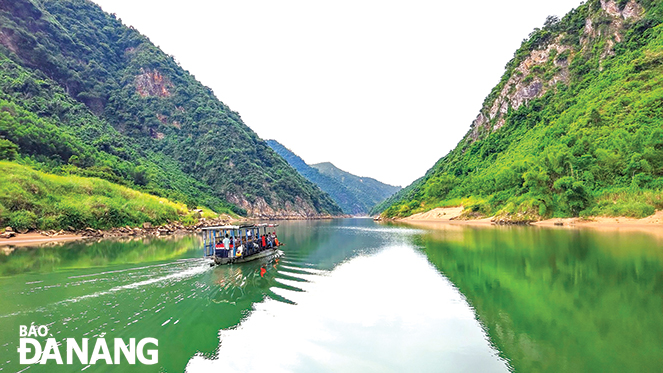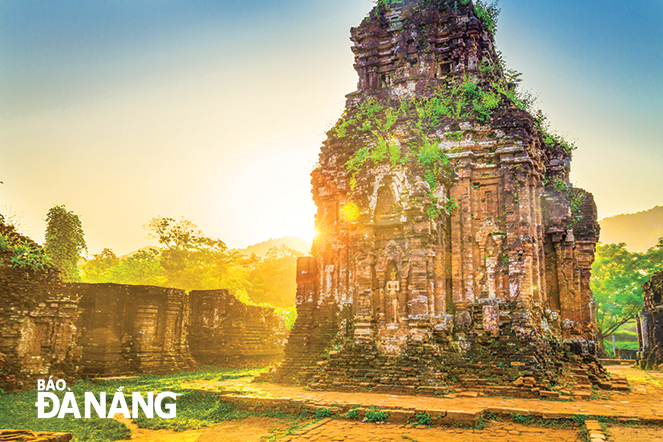Over the course of their history, the close connection between Quang Nam and Da Nang that are known as a "sacred land with pre-eminent people" has made them different from other Vietnamese localities. Quang Nam and Da Nang boast hundreds of kilometers of coastline stretching from the foot of the Hai Van Pass to Nui Thanh, the primeval forests of Ba Na - Nui Chua, Tra My, Nong Son, the midland hills of Tien Phuoc, and the delta region including Dien Ban, Duy Xuyen, and Dai Loc, along with interconnected river networks.

A breathtaking view of the Hon Kem-Da Dung tourist site
The Thu Bon River with its basin area of 10,350km² is one of Viet Nam’s longest inland rivers. The river originates from the Ngoc Linh Mountain in Dak Glei District, Kon Tum Province, and drains into the ocean at the Cua Dai Beach, Hoi An City, Quang Nam Province. A branch of The Thu Bon River flows into the Vinh Dien River, and then pour water into the Han River in Da Nang. The Thu Bon River has many sub-parallel, straight segments, stretching from Tam Ky, Hoi An to the Han River in Da Nang.
Tapping full potential of river tourism in the two localities
With many sub-parallel, straight segments, the Thu Bon River has created the intricate connection between Quang Nam and Da Nang, which is regarded as a rare opportunity for the two localities to unlock their full potential to promote the development of river tourism. Especially in the summer and spring days, tourists can take boat tours to explore beautiful scenery of the banks of the Thu Bon River with rice fields and lush green trees. How interesting it is!
The political reports of the Party Congresses of Quang Nam and Da Nang in recent years have put as much emphasis on gradually opening new waterway routes connecting with tourist attractions in the two localities, promoting the development of river tourism and hydroelectric dams, as well as boosting tourism cooperation between the two localities, and the East and West regions in a bid to improve the quality of their tourism products to tap into their full potential of river tourism.
Quang Nam and Da Nang are on a right track to exploit their advantages of rivers to create unique tourism products in efforts to attract tourists.
Opening new waterway routes as soon as possible
In their efforts to realize their goals, Quang Nam and Da Nang will together create their own master plan for tourism development, including river tourism, in both two localities as soon as possible. For example, special attention will be paid to developing new tours along the Thu Bon River to connect tourists with such tourist attractions as famous Go Noi Village, the Lady Thu Bon’s Temple, the My Son Sanctuary, Hon Kem - Da Dung, a former revolutionary base which lies on the upper section of the Thu Bon River in Quang Nam Province’s Que Son District while it has two ranges of rocky mountains which have been dissected and eroded by the river to create amazing images and patterns, the Thanh My Wharf which used to be a wharf for boats to pick up military officers and soldiers, transport food and weapons from the mountains to the plains, or from the plains to war zones.

The UNESCO-recognized heritage My Son Sanctuary.
It is necessary for Quang Nam and Da Nang to choose a key area to develop their river tourism. Located on the shores of the poetic Hoai River, the Hoi An accient town is enchanting in its serene antique beauty. There are rows of old houses with mossy tiled roofs and distinctive yellow-lime walls. After hundreds of years, people going to Hoi An still can see the silhouette of a busy trading port, imprinted in more than 1,000 monuments on the streets, in the houses, assembly halls, pagodas, shrines, churches and ancient wells. They can even be seen in small alleys, the traditional dishes and the manner and hospitality of the people. Exuding an ancient vibe similar to Lijiang (China) or as romantic as Venice (Italy) or tranquil like Giethoorn (Netherlands) these are popular descriptions of Hoi An in Quang Nam by most tourists who had the chance to visit this place also known as the "city of titles". As early as the end of the 16th century, this town harbored cultures from all around the world. Next to the bold imprint of Vietnamese culture, one can also see in Hoi An the colors of China, Japan, and also Western countries such as the Portuguese, Spanish, Dutch and French who were traders from many centuries ago. The colors, sounds and rhythms of life blend together to create a cozy, friendly, peaceful and romantic Hoi An that is like no other city in Viet Nam, and in the world at large.
The ancient town of Hoi An was recognized as a UNESCO World Cultural Heritage site in 1998, and has become one of the top holiday destinations in Viet Nam, attracting a large number of domestic and foreign tourists. They are deeply impressed with ancient, peaceful, environmentally-friendly, open, and simple characteristics of Hoi An.
Choosing Hoi An as a key point for promoting river tourism in Quang Nam and Da Nang is suitable and easy for the two localities to attract tourists. On the other hand, departing from Hoi An, tourists can take boat tours along rivers to explore such tourist attractions as the Han River in Da Nang, Dien Ban, Duy Xuyen, Dai Loc, Que Son, Nong Son, Thang Binh and Tam Ky, all in Quang Nam Province. The soon-to- be developed Da Nang Han River Marina will serve as the starting point for the waterway tourism route of both Quang Nam and Da Nang. This is considered a rare opportunity for the two localities to unlock their full potential of river tourism in both the immediate and long term benefits.
Another important issue is renovating the existing waterway routes in the two localities. Quang Nam and Da Nang have worked together to make plans for dredging the Co Co - De Vong River, and Truong Giang River for several years. The use of the Co Co - De Vong River for waterway tour development will help promote the development of both tourism and infrastructure on both banks of the river stretching over 30km.
Furthermore, the land facing the sea stretching from Hai Van Pass to Hoi An has been largely devoted to developing hotels, resorts, and beaches. Therefore, the Co Co - De Vong River dredging project will help create ecological urban areas, tourist sites, and beautiful villages along this river, thereby creating a poetic, peaceful and attractive rural riverside landscape. Hence, Quang Nam and Da Nang should pay special attention to boosting their cooperation to realize their goals in the coming years.
Heed should be paid to reopening the waterway route along the Truong Giang River connecting Hoi An with Tam Ky, as well as reopening another one along the Thu Bon River linking Hoi An with other localities. The reopening of these waterway routes will encourage these localities to develop ecological, heritage, community-based, and craft village tourism. These things will help residents in riverside rural areas to increase their income by playing their part in tourism development.
Remarkable achievements that the tourism sector of Quang Nam and Da Nang have achieved in recent years give them confidence to unlock their full potential of river tourism to drive the growth of the sector in the two localities in the years ahead.
Reporting by Le Minh Hung - Translating by H.L